.jpg)
(Photo: Unsplash)
Global food prices have seen huge fluctuations in recent years, soaring to record highs in 2022 before dropping in 2023 and rising again slowly this year.
Extreme weather events, geopolitical conflict, high input costs and increased demand all contributed to these spikes, experts told Carbon Brief in June.
The impact of these events varies depending on the type of food – olive oil, orange juice and other common supermarket items are now more expensive, for example, whereas grains have dropped in price compared to the start of this year.
This price volatility is “likely to be an increasingly common feature of our highly integrated global food systems”, Prof Elizabeth Robinson, director of the Grantham Research Institute on Climate Change and the Environment, told Carbon Brief earlier this year.
Food inflation has even featured in the US presidential election campaign, with Democratic nominee Kamala Harris proposing to ban “price gouging” on groceries by corporations.
Carbon Brief has produced five charts – each focused on a specific area – to show how climate change can impact food production and price.

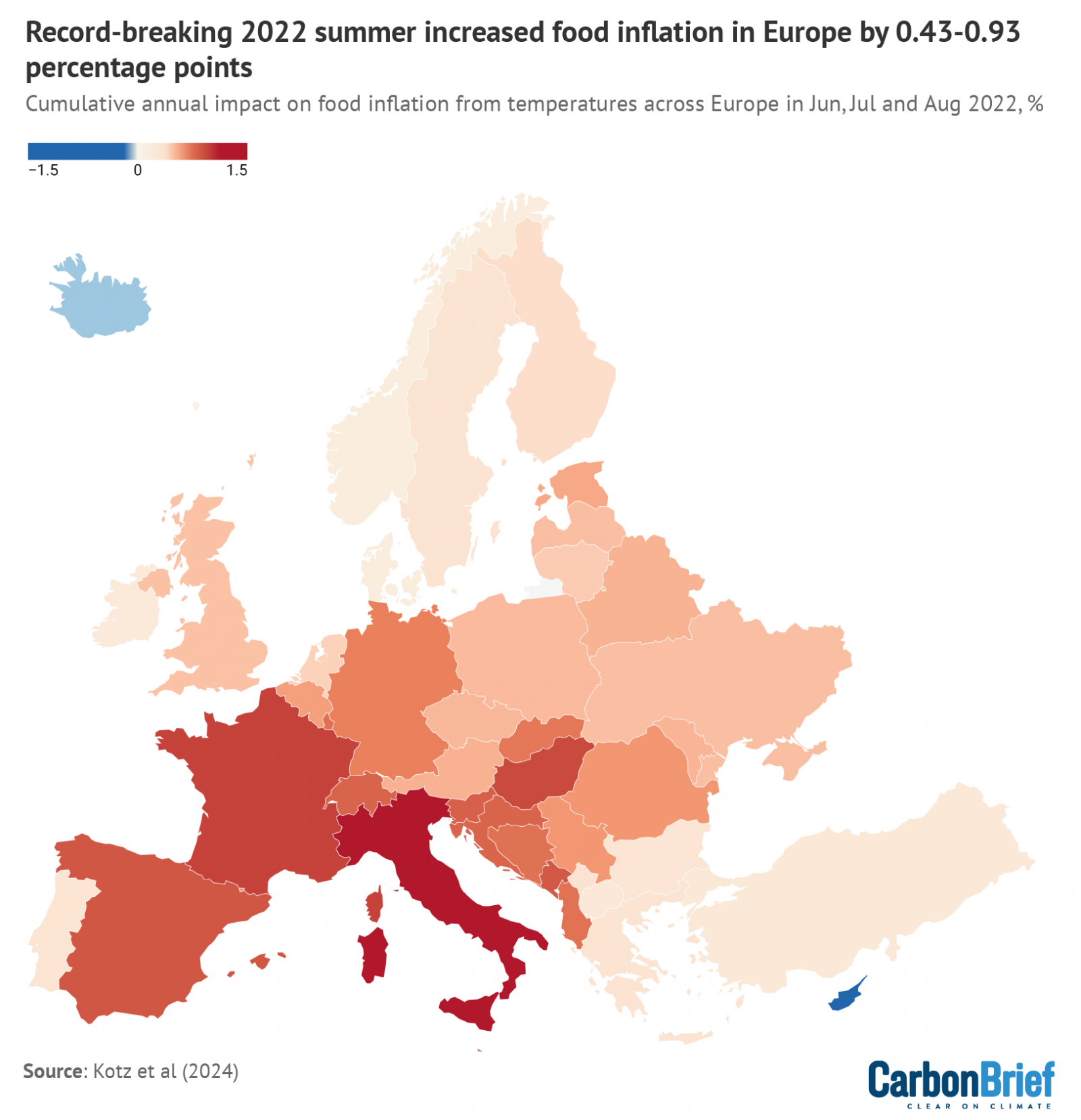
The change in food inflation due to the higher-than-average temperatures in Europe in June, July and August 2022. Red indicates an increase in food inflation and blue indicates a decrease. Credit: Carbon Brief, based on Kotz et al. (2024)
Extreme heat can influence food prices around the world. A 2024 study found that high temperatures “persistently” increase food inflation in both high- and low-income countries.
Combining climate data with more than 27,000 monthly observations of consumer price indices for food eaten at home and in restaurants in 121 countries, the researchers quantified the impact that temperatures had on inflation between 1996 and 2021.
They found that higher temperature during already hotter months caused the biggest increases in food inflation. This “implies short-term rises in inflation from exceptionally hot periods”, the authors write – including the intense summer of 2022.
The above map, based on data from this study, shows how much Europe’s hottest summer on record impacted annual food inflation.
Countries across Europe faced “unusually intense and widespread” heatwaves in the summer months in 2022, according to the EU’s Copernicus Climate Change Service. The heat broke many records, contributed to wildfires, killed more than 60,000 people and affected hundreds of millions more.
The heat impacted the cost of food, the study found, with food inflation increasing by 0.43-0.93 percentage points.
European food inflation varies each year, generally staying below 5%, but it can spike much higher. Rates soared by as much as 19% during parts of 2022 and 2023.
Food and energy inflation rose sharply in 2022, in particular, for a number of other reasons, including Russia’s invasion of Ukraine and surging demand in the wake of the Covid-19 pandemic.
The study also warned that levels of extra warming projected to hit Europe by 2035 would amplify food inflation by 30-50%.
Dr Maximilian Kotz, a lead author on the study and postdoctoral researcher at the Potsdam Institute for Climate Impact Research, was surprised by the “extent to which these impacts could be amplified already over the next 20 years by further climate change”.
He tells Carbon Brief that reducing greenhouse gas emissions and adapting agricultural productivity are among the actions needed to reduce risks:
“We see the magnitude of impacts grows considerably under scenarios of unmitigated future greenhouse gas emissions, whereas they plateau in scenarios where greenhouse gas emissions are reduced to net-zero in line with the 2C warming target.”

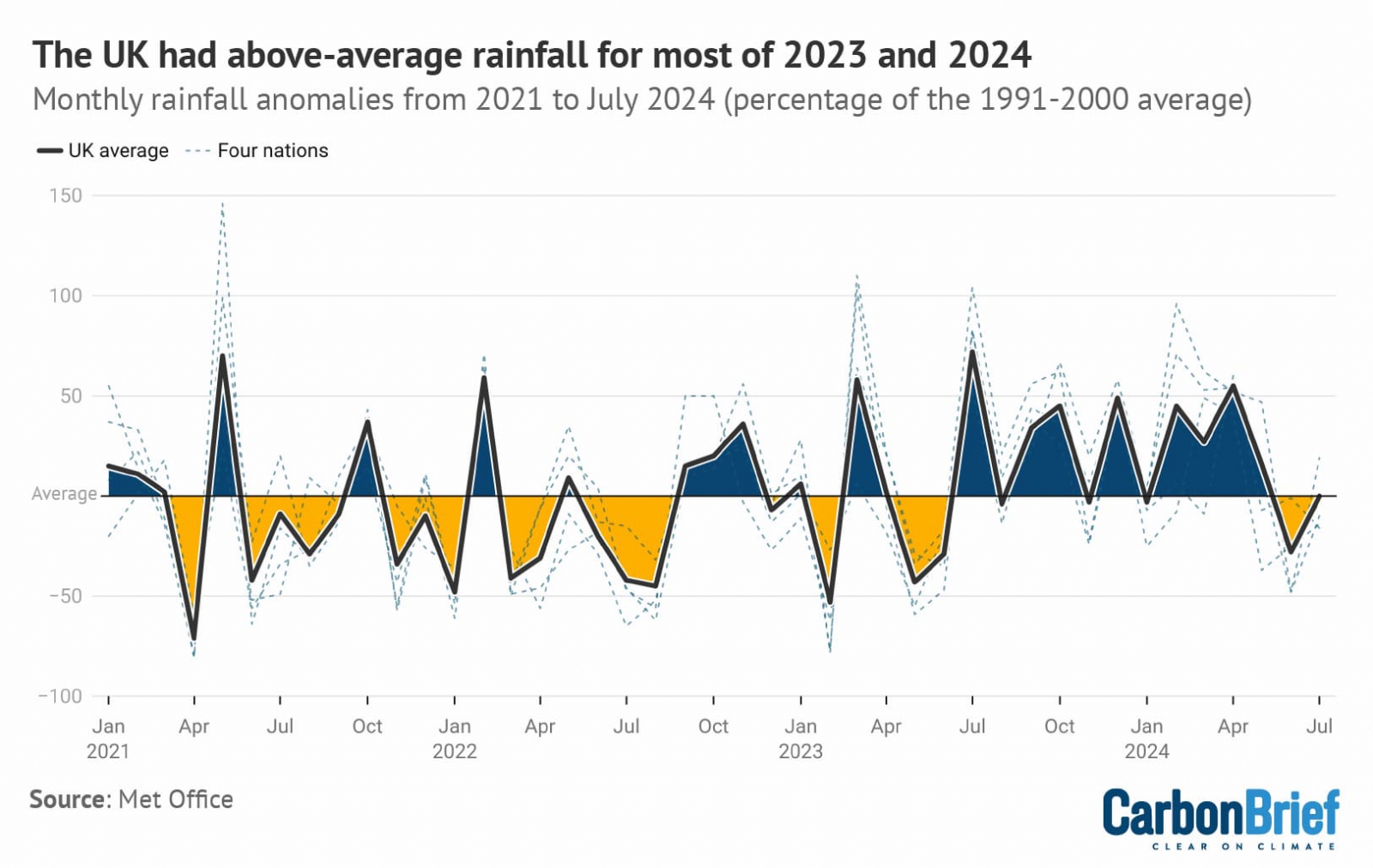
UK monthly rainfall anomalies from January 2021 to July 2024. Figures above the baseline indicate higher-than-average rainfall levels (dark blue shading) and those below the baseline indicate less rain (yellow shading), compared to average levels from 1991-2020. The thick blue line represents the average rainfall across the UK, and the dotted light blue lines indicate figures for England, Wales, Scotland and Northern Ireland. Credit: Carbon Brief, based on data from the Met Office.
In 2023, the UK experienced its second-warmest and seventh-wettest year since records began in 1836, according to the Met Office.
England also had its wettest 18 months on record from September 2022 to February 2024.
As the above chart shows, monthly rainfall totals rose to above-average levels more often than not during this period. In July 2023, they were more than 170% higher UK-wide than average levels from 1991-2020.
All of this had a major impact on farming, with high rainfall levels leaving soils waterlogged and affecting crop planting times. UK production of vegetables dropped by 4.9% in 2023 compared to the year prior, according to figures from the UK Department for Environment, Food and Rural Affairs.
In 2023, cauliflower yields fell by just over 9% and the lowest area of bulb onions in “several decades” was planted, the figures showed.
UK farms have “faced continuous wet weather” since the end of last year, the president of the National Farmers Union, Tom Bradshaw, said in a statement in March 2024.
Bradshaw claimed that many farms were “still under water from last October”, when intense rain from Storm Babet hit the UK. He added that union members were struggling “to get on to their fields to plant any crops” after the extreme weather.
In February, the Guardian spoke to a crop farmer who anticipated an “appalling” yield after the winter rain. Another arable farmer in the south-west of England recently told BBC News that he is down thousands of pounds and around half of his wheat crop this year, adding that “it has been catastrophic”.
The overall production of winter wheat, winter barley, spring barley, oats and rapeseed is estimated to drop by 17.5% this year compared to 2023, according to analysis from the Energy & Climate Intelligence Unit.

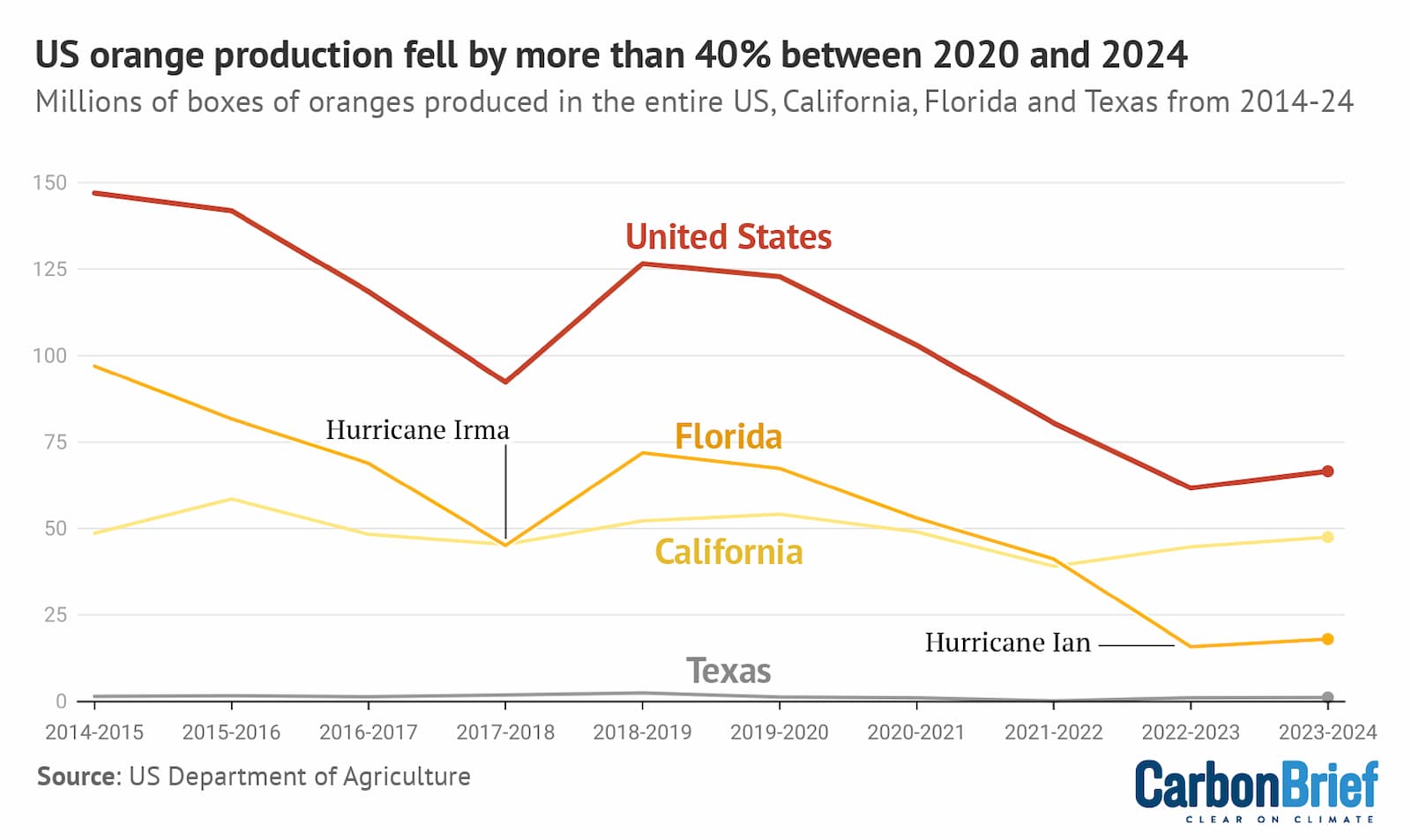
Orange production in the US (red) and on a state level in Florida (orange), California (yellow) and Texas (grey) in millions of boxes from 2014-24. Production dropped significantly in Florida during this time, partly due to Hurricanes Irma and Ian. Credit: Carbon Brief, based on data from the US Department of Agriculture.
Orange juice prices have steadily increased in recent years in the US, NBC News reported, due to declining production in Florida and “climate-fuelled extreme weather” in Brazil.
Diseases and extreme weather have been “ravaging orange groves in some top-producing countries” in recent years, the Associated Press said, with this year’s harvest in Brazil forecast to be the “worst in 36 years, due to flooding and drought”. Brazil is the biggest orange producer in the world.
In the US, the third-biggest grower, orange production dropped by more than 40% between 2020 and 2024, as shown in the above chart. Florida’s production more than halved between the 2021-22 and 2022-23 harvests.
This was partly due to Hurricane Ian, which made landfall in September 2022 and devastated the orange crop in Florida. Around 90% of the state’s “citrus belt” was in the path of the hurricane, Bloomberg said at the time.
The hurricane had at least 10% more rain due to climate change, according to a rapid attribution analysis published soon after the storm, which was covered by the Associated Press.
In addition to storms, oranges around the world have been hit by an “incurable citrus greening disease that is spread by an invasive insect, rendering fruit unusable” over the past couple of decades, the Guardian said. Florida oranges have been badly affected by the disease.
“Some in the business liken it to a measles outbreak,” according to Chemical & Engineering News. The disease is the “most serious threat to the US citrus industry in history” and costs growers millions of dollars each year, the US Department of Agriculture (USDA) said.
(Citrus greening is spread by a small insect. Rainfall and temperature do not have a strong link with the spread of this insect or citrus greening in tangerines, a 2024 study found, but other research said that climate change can expand the range of plant pathogens.)
All of this has led to soaring prices. In June 2024, orange juice cost $4.26 per 16 fluid ounces (£3.30 per 473ml) – nearing double what it cost in four years prior at $2.36 (£1.83), according to the USDA.

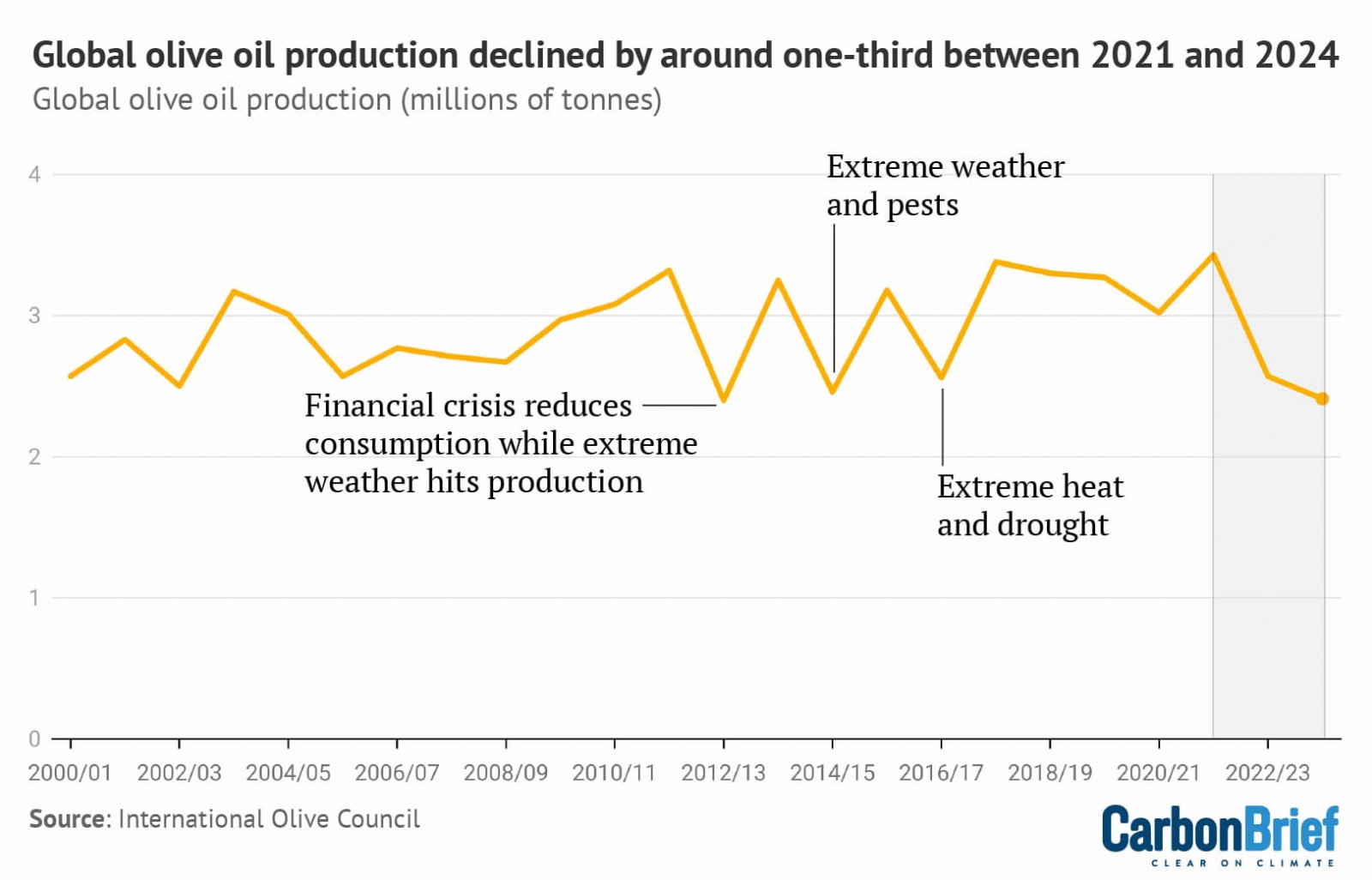
Global olive oil production, in millions of tonnes, from 2000-24. Credit: Carbon Brief, based on figures from the International Olive Council.
As the above chart shows, global olive production has dropped significantly since 2021. Production dropped by approximately one-third between 2021 and 2024.
As a result, the price of olive oil has soared in different parts of the world. In January 2024, the cost had risen by almost 70% in Portugal compared to January 2023, according to Eurostat. Prices were up by 50% in the EU, on average, during this time period.
Olive oil is now the “most stolen product in supermarkets across Spain” due to the price tag, the Guardian reported in March.
Sales “plunged” in parts of the Mediterranean due to “steep price rises”, the Financial Times wrote earlier this year. The outlet noted:
“Droughts and heatwaves, exacerbated by climate change, have knocked olive oil output in Spain, the world’s largest producer, as well as other major producing countries such as Italy and Greece, creating a global shortfall.”
Olive trees in Mediterranean countries grow a large portion of the world’s olive oil, with Spain alone producing more than 40%.
Satellite images from NASA’s Earth Observatory, indicate that Spain was “browned by drought” between the Mays of 2022 and 23. This drought “dried up reservoirs, parched olive groves and led to water restrictions across the country”, NASA said.
Spain saw record-breaking temperatures across almost half of the country in 2022, according to a 2023 study. The researchers noted that “despite normal rainfall conditions, the extremely high temperatures led to intense drought conditions in most areas”.
The olive crop in Spain has shown signs of improvement since 2022.
Officials said production reached more than 850,000 tonnes in 2023-24. This is still “significantly below the five-year average”, but 28% higher than the “historically poor harvest” of 2022-23, the Olive Oil Times reported.

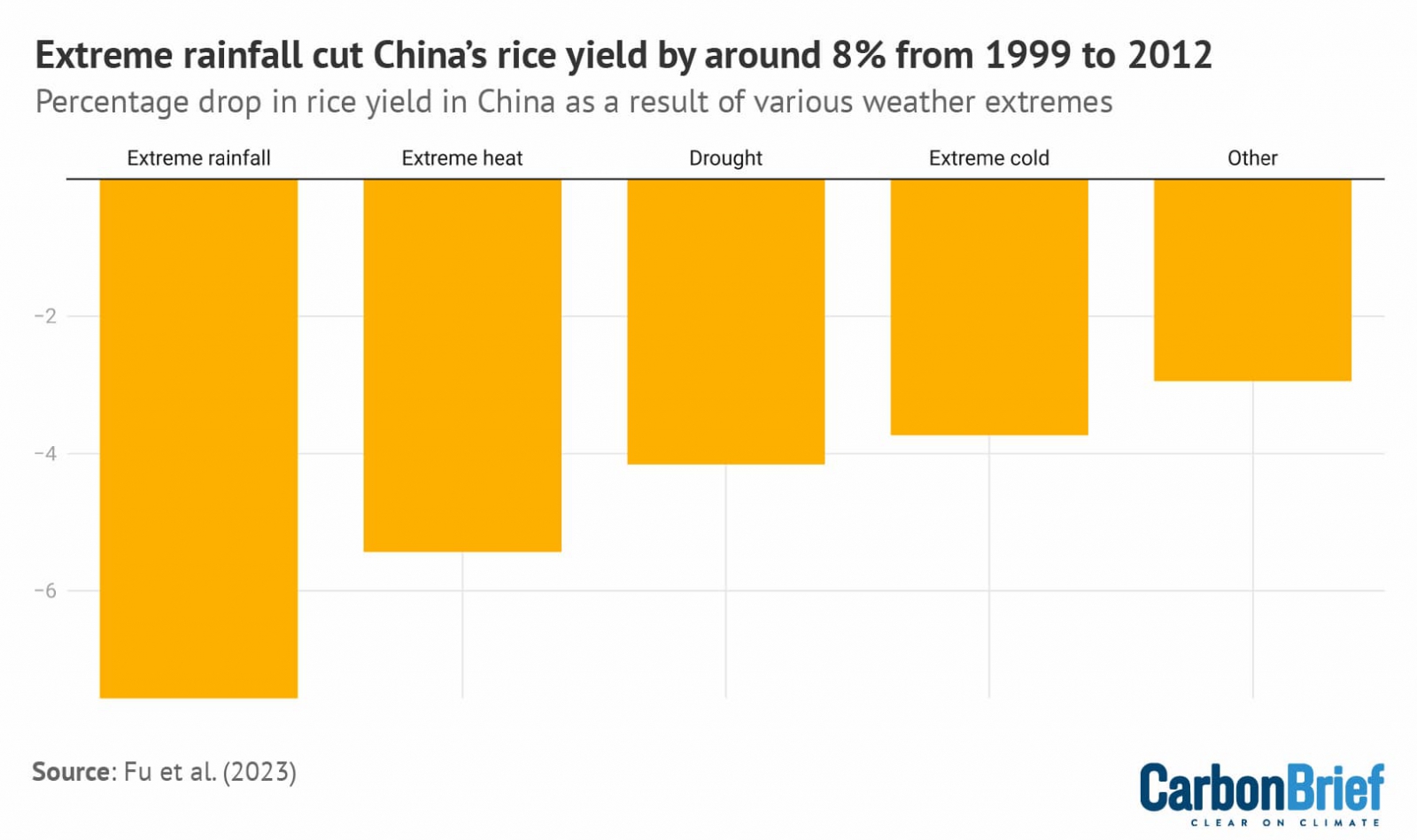
The percentage drop in China’s rice yield as a result of extreme rainfall, heat, drought, cold and other forms of extreme weather from 1999-2012. Credit: Carbon Brief, based on Fu et al. (2023)
China is a major producer of cereals – growing more rice and wheat than any other country in the world.
The chart above, based on the findings of a 2023 study, shows that extreme rainfall cut rice yields in China by around 8% from 1999-2012.
The researchers analysed long-term national observations and model simulations, both showing similar results on the impact of extreme rainfall on rice yields.
Heat, drought, cold and other forms of extreme weather also negatively impacted rice yields during this time, the chart shows.
Separate government data shows that rice production fell by 3% between 2018 and 2023. Wheat rose by almost 4% and corn by almost 12% during this time.
A 2018 report from China’s Ministry of Ecology and Environment outlined that climate change has “significantly impacted cropping systems”. Climate change will bring less reliable rains, enhance the spread of dangerous pests and result in shorter growing seasons for many crops in China, the report added.
China has been hit by a deluge of high temperatures, floods, drought and other forms of extreme weather over the past few years.
July 2024 was China’s hottest month since comprehensive records began in 1961, according to Reuters. The country has also faced 25 large-scale floods so far this year, the state-supporting Global Times said, which is the highest since records began in 1998.
This year, farmers in Henan province – China’s eastern “agricultural heartland” – have been dealing with “parched crops” followed by extreme rainfall just one month later, CNN reported. The outlet said:
“Parts of Henan’s hardest-hit Nanyang city saw more than 600 millimetres (about 24 inches) of rain in 24 hours – three-quarters of what they would normally expect in a whole year.”
Drier soils are not able to absorb water as quickly as moist ones, so intense rainfall after a period of drought can lead to water running off the surface of the soil and causing floods.

The cost of some fruits and vegetables, such as cabbage, spinach and pears, has “risen sharply” in China since June, Reuters recently reported, after floods and heat that “devastated millions of acres of farmland and is now hitting consumers in their pockets”.
Last year, Carbon Brief reported on the impact climate change is having on China’s cropland. Severe drought followed by heavy rains and floods last summer destroyed corn, rice and wheat crops around the country.
This article was originally published on Carbon Brief under the Creative Commons BY NC ND licence. Read the original article.




